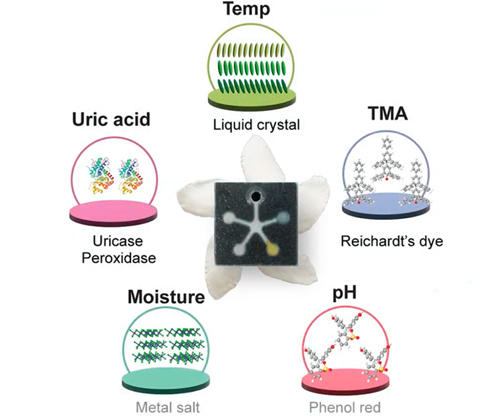
Researchers at the National University of Singapore have created a wound sensor patch that measures various wound biomarkers that can indicate would healing. Chronic wounds are an ongoing problem for many patients, and developing new ways to monitor and treat these painful lesions would be very useful. This battery-free wound patch contains five colorimetric sensors that change color in response to various wound biomarkers. These include temperature, pH, trimethylamine, uric acid, and wound moisture levels. The patch is intended to be imaged using a smartphone camera, where an AI-powered app analyses the color change to distinguish between healing and non-healing wounds. Together, these five markers provide a snapshot of wound healing, and the sensor could potentially provide early warning of any issues that are developing and require early treatment.
Chronic wounds are a growing problem, with diabetes and our aging population playing a role. These lesions are difficult to manage and heal, and can significantly affect patient quality of life and lead to additional serious complications, such as gangrene. Identifying developing problems in a wound as early as possible can enable early treatment, and researchers are developing new ways to monitor wounds with the least amount of disruption for patients and healthcare staff.
“To address this challenge, NUS researchers combined our expertise in flexible electronics, artificial intelligence (AI) and sensor data processing with nanosensor capabilities of IMRE researchers to develop an innovative solution that could benefit patients with complex wound conditions,” said Benjamin Tee, a researcher involved in the study.
This latest technology achieves this with a flexible, paper-like wound sensor patch. The researchers have termed their technology the PETAL (Paper-like Battery-free In situ AI-enabled Multiplexed) sensor patch. It contains five colorimetric sensors that each measure a specific wound biomarker. The patch is affixed to the wound, and liquid from the wound bed is wicked into the patch and enters the sensors, where it can provide a result in as little as 15 minutes.
The patch measures temperature, pH, trimethylamine, uric acid, and wound moisture levels. The researchers chose these biomarkers, as together they provide an overall view of wound healing status, infection and inflammation. Once the color change has occurred, the patch can be imaged using a smartphone camera, before an AI-powered system analyzes the color change and provides an aggregate score of wound healing status.

“We designed the paper-like PETAL sensor patch to be thin, flexible and biocompatible, allowing it to be easily and safely integrated with wound dressing for the detection of biomarkers,” said Su Xiaodi, another researcher involved in the study. “We can thus potentially use this convenient sensor patch for prompt, low-cost wound care management at hospitals or even in non-specialist healthcare settings such as homes.”
Video about the technology : https://youtu.be/bju2XgTBdOc
Source: Medgadget




